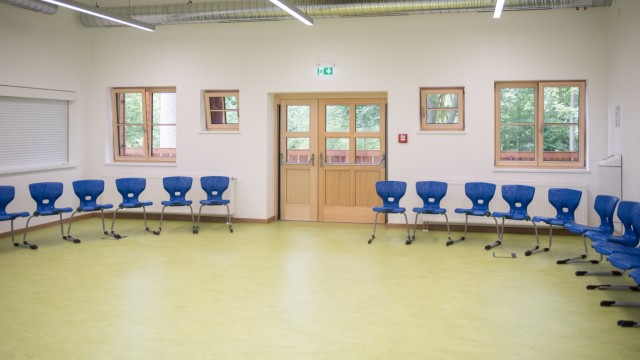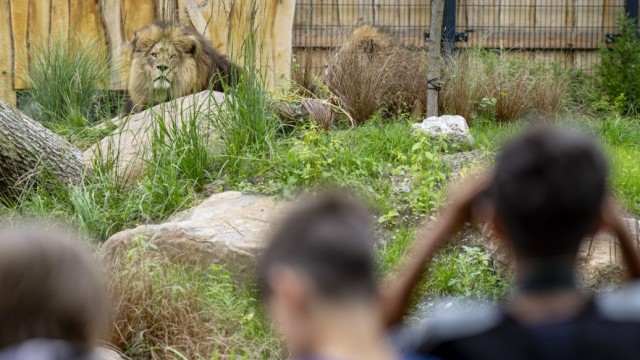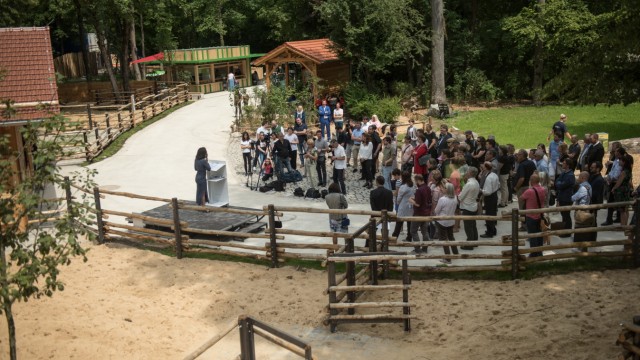Three quarters of all German families visit a zoo at least once a year. Most of the students in grades 4a and 4c from Pfaffenhofen are also not at Hellabrunn Zoo for the first time. The ten and eleven year olds routinely walk past flamingos, meerkats and Bulgarian long-haired goats. On this day they have a special destination: the zoo school in Mühlendorf at the southern end of the zoo. A first for the almost fifty children and their three teachers.
It has been five years since Hellabrunn director Rasem Baban ceremoniously opened the zoo school. In 2019, the zoo team was enthusiastic about the 4.7 million euro new building with a farmhouse look in Hellabrunner Mühlendorf. The pandemic has since put the brakes on some promising educational projects – including the zoo school. It was built on property belonging to the zoo, but is financed and operated by the city of Munich. When Sandra Buchberger, a secondary school teacher for sports and business, took over management in March 2023, she knew: There was a lot to do. Expensively purchased tablets lay untouched in the cupboard, and modernly equipped classrooms eked out an existence that received little attention.
The effort has borne fruit: At the beginning of this year, the Hellabrunner Zoo School received the national Unesco award “Education for Sustainable Development”, or ESD for short. Together with the Federal Ministry of Education and Research, the UNESCO Commission awards educational institutions that advance innovative teaching concepts to preserve the planet.
The age of the children and the type of school they attend do not play a role at the zoo school. Thematically, all modules offered can be flexibly adapted to the students: Every school subject can be linked to the zoo school’s offerings and to sustainability and environmental topics, assures Sandra Buchberger. Tours can be held bilingually, and instead of doing sports in your own gym, you can take the “Elephant Dance” module in Hellabrunn, in which younger children in particular move actively in front of the elephant house. Young adults, on the other hand, are more likely to attend the zoo school in order to question the concept of zoos, for example with the ethics course. The big difference to other zoo schools in Germany is the interdisciplinarity of the Munich facility. In other projects, the focus is usually on classical zoology and biology, explains Buchberger.
Lessons on the tablet are only part of the program: Sandra Buchberger (2nd from left) also gets close to the animals with her guests.
(Photo: Private)

The zoo school is ideally prepared for groups of students.
(Photo: Corinna Guthknecht)

Keeping an eye on the lions: children from the zoo school on observation posts.
(Photo: Marc Müller/Hellabrunn Zoo)
Buchberger is waiting for the two school classes at the school gate. For the 48-year-old, many threads come together: organization, digitalization, billing, press work and the actual teaching are handled by her and her colleague Christina Neuenhagen, 46, as a pair. A lot has changed since Buchberger took office a year ago: concepts, ideas and processes that were sometimes only passed on from employee to employee in the zoo school, which has existed since 1987, have now been written down. The full potential of the extracurricular learning location should now be exploited. However, four of the six jobs in the school office are currently vacant – so the offer could definitely be expanded.
Unlike most of the children in her class, primary school teacher Katharina Weiß, 28, is in Hellabrunn for the first time: “The children are doing things in a completely different way than in the classroom. Here they can compare: What was the model like, what is it like on the model? real animal?” As she knows, her students have a lot of prior knowledge of topics such as sustainability and environmental protection – from school but also from home. Almost all of her primary school students are familiar with the term microplastics. It is easy for them to explain why plastic waste in the oceans poses a danger to humans and animals. Weiß and her two colleagues found out about the Munich project and the selectable modules through their college in Pfaffenhofen – where they now recommend the educational offerings to each other.

The extracurricular offering in Mühlendorf opened in 2019.
(Photo: Corinna Guthknecht)
Buchberger and Neuenhagen also observe that children sometimes bring a lot of knowledge with them to the zoo school. But you can also see that there are big differences between districts. In order to create equal opportunities and educational justice, the contribution that school classes pay for the modules is very low: one euro per student. In addition, there is an entrance fee to the zoo of seven euros. The director was also recently able to negotiate a discounted lunch offer for students in the zoo restaurant for five euros: “Money should not be a criterion for education,” says Buchberger.
Another bite, a quick sip, and then the children from 4a and 4c hurriedly stow the half-eaten sausage sandwiches and apple juice bottles in their backpacks before we get started. An urgent note should not be missing: sharing snacks with each other is allowed, but for heaven’s sake you are not allowed to feed the animals.
The school classes get going: With maned seals, polar bears and Humboldt penguins, the children listen to the explanations, observe carefully and ask questions. On a worksheet they then briefly explain what an ecological footprint is and why some species are threatened by climate change. The animals show their best side, even the polar bears in the cold water play with their balls. They have no idea about the climate catastrophe and their threatened Arctic counterparts.

